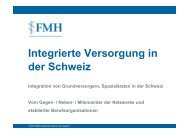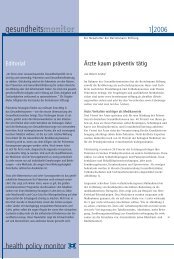The 2nd HPD report - Health Policy Monitor
The 2nd HPD report - Health Policy Monitor
The 2nd HPD report - Health Policy Monitor
- TAGS
- health
- policy
- monitor
- www.hpm.org
Create successful ePaper yourself
Turn your PDF publications into a flip-book with our unique Google optimized e-Paper software.
eimbursement rate is 35 percent. Most drugs belong to this<br />
category.<br />
– <strong>The</strong> remainder, drugs with an insufficient SMR, is not<br />
reimbursed; the patient or the patient’s supplemental insurance<br />
pays the full cost.<br />
<strong>The</strong> “Commission de Transparence,” a commission of physicians,<br />
pharmacists, members of the health insurance association<br />
and representatives from the pharmaceutical industry, issues<br />
recommendations based on this classification. Between 1999 and<br />
2001, the commission evaluated all of the 4,200 listed pharmaceuticals<br />
with respect to each possible indication. Based on its<br />
findings, the commission recommended reducing the reimbursement<br />
for 840 drugs from 65 percent to 35 percent and excluding<br />
another 835 drugs from the list of reimbursable drugs<br />
altogether. Until 2003, however, only a few drugs were actually<br />
delisted or moved to a lower reimbursement category.<br />
In April 2003, the MoH implemented a new system, reducing<br />
the reimbursement rates for 617 drugs. Pharmaceutical companies<br />
raised an outcry, criticizing the criteria for reimbursement<br />
and reevaluation of the drugs and accusing the “Commission de<br />
Transparence” of inconsistency. Taking their case to court, on the<br />
grounds of breach of procedural rules and insufficient justification<br />
for reducing the rate, some of the affected companies won<br />
rulings that reversed the decreased reimbursement for 12 drugs.<br />
Some scientists criticize the SMR criteria as too narrow in<br />
scope. <strong>The</strong>y argue that the criteria should consider not just efficacy,<br />
but also benefit-risk-ratios, social dimensions and equity<br />
aspects. Furthermore they argue that the consequences of this<br />
policy have not been evaluated.<br />
In response to these criticisms, the MoH decided to implement<br />
the delisting in three waves spread out over three years. In<br />
the first wave, 84 drugs were delisted in summer 2003. <strong>The</strong> MoH<br />
also reorganized the “Commission de Transparence” in September<br />
2003, changing the composition of its membership.<br />
51<br />
Evaluations to<br />
little effect<br />
Drug companies<br />
fight further<br />
reimbursement cuts<br />
Delisting criteria<br />
lack equity<br />
dimension<br />
MoH speeds<br />
up delisting in<br />
response to critics






